


27/08/2013
FEATURE BY MATT SOMERFIELD
The 4.35 mile (7km) Spa-Francorchamps circuit, set in the Ardennes Forest, is a throw-back to Formula One's past, sanitized over the years with both safety measures introduced to the circuit’s layout and the ongoing development of the Formula One machines meaning the once ferocious circuit is now slightly tamed.
Laying in wait for the grid's 22 drivers remain some of the most challenging corners on the calendar, none more so than the famed Eau Rouge/Raidillon combination that sees the drivers climb the 35 metre hill whilst piff-paffing left, right and then left again with the last being blind as the car crests the summit.
This combination of corners is a test not only for the driver's skill but his body as well, with compression being a factor as the car climbs and turns. The now flat-out combination of corners also puts strain on the tyres and engines alike with around 1000kgs of load placed on the tyres (data from Pirelli) at its peak whilst the steep change in altitude puts pressure on the engine to keep producing power.
The rest of the lap however is no picnic and requires compromise to be made with the setup of the car. Split into three sectors, one and three are much lower downforce than two with the complexity of the second sector ideally requiring much more downforce. Other factors that must be considered are adverse camber angles and bumpy braking zones (especially the most severe braking zone at the end of the lap into the former bus stop chicane) which challenge the drivers throughout the lap.
Red Bull Racing
 The team is often criticized as it appears from the outside to not be flexible in its approach to aerodynamic configuration, always taking the highest downforce available. During Friday's free practice sessions however it became clear that the team was relinquishing some downforce for straight-line speed with the drivers testing lower downforce rear wings.
The team is often criticized as it appears from the outside to not be flexible in its approach to aerodynamic configuration, always taking the highest downforce available. During Friday's free practice sessions however it became clear that the team was relinquishing some downforce for straight-line speed with the drivers testing lower downforce rear wings.
The image on the left (click to enlarge) shows an extremely shallow angle of attack being used and whilst this wing didn't differ significantly to the one used by the team during qualifying and the race it was really being tested for the last European race of the season at Monza.
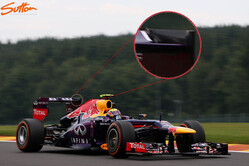 As we can see in the magnified section of this image (right) this extremely low downforce wing doesn't feature the louvres we normally see in the endplates. The louvres are placed in a normal configuration rear wing's endplates in order to bleed some of the low pressure into the high pressure region. This is done to reduce the formation of wing tip vortices that are generated as the wing becomes loaded. These vortices are harmful to the flow structure of the wing as without the louvres the vortices would spool up either side of the wing making the outer portion of the wing less effective. The louvres don't eradicate the vortices completely but straighten them for much longer reducing the drag induced.
As we can see in the magnified section of this image (right) this extremely low downforce wing doesn't feature the louvres we normally see in the endplates. The louvres are placed in a normal configuration rear wing's endplates in order to bleed some of the low pressure into the high pressure region. This is done to reduce the formation of wing tip vortices that are generated as the wing becomes loaded. These vortices are harmful to the flow structure of the wing as without the louvres the vortices would spool up either side of the wing making the outer portion of the wing less effective. The louvres don't eradicate the vortices completely but straighten them for much longer reducing the drag induced.
 The image (left) shows the rear wing actually employed by Red Bull for qualifying and the race which in itself still has a shallow angle of attack (AoA) and does have 3 louvres in the endplate maximising efficiency for the additional AoA.
The image (left) shows the rear wing actually employed by Red Bull for qualifying and the race which in itself still has a shallow angle of attack (AoA) and does have 3 louvres in the endplate maximising efficiency for the additional AoA.
We can also note from this image that the mainplane has 4 angles at which it can be set and the team had opted for the shallowest when the image was taken. Also noteworthy are the ‘V grooves' we see in the trailing edge of the top flap, Red Bull usually opt for a large V groove in the centre of the flap but on this wing it's a much smaller V. This is another method of reducing drag when running higher AoA's and so with the shallower angle the team plays one compromise off another.
Lowering the downforce of the car must be balanced and so at the front of the car the team has once again opted to change the nose design, placing the FOM cameras in a more neutral position than their usual hammerhead configuration. To cause less airflow constriction the team has also deleted the small under nose 'Pelican' bulge its other nose utilises.
Mercedes
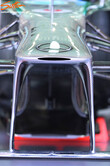 A team certainly on the up, but after the last few seasons stuck in the doldrums trying to make the best of the Pirelli tyres the team seems to be heading in the right direction. Having made the expensive switch from 50 to 60% wind tunnel usage the team seems to be getting exceptional correlation with parts being bought to the track responding as expected. Spa was always likely to suit Mercedes which has shown, even on high downforce circuits, that its car is quick in a straight line too, topping the speed traps on many occasions. As we know though you cannot afford to stand still in F1 and so the team took aero upgrades to Belgium.
A team certainly on the up, but after the last few seasons stuck in the doldrums trying to make the best of the Pirelli tyres the team seems to be heading in the right direction. Having made the expensive switch from 50 to 60% wind tunnel usage the team seems to be getting exceptional correlation with parts being bought to the track responding as expected. Spa was always likely to suit Mercedes which has shown, even on high downforce circuits, that its car is quick in a straight line too, topping the speed traps on many occasions. As we know though you cannot afford to stand still in F1 and so the team took aero upgrades to Belgium.
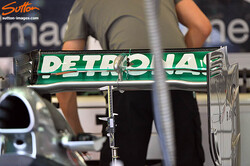 In a side step, much like Red Bull the team also returned to a nose without the 'Pelican' bulge
In a side step, much like Red Bull the team also returned to a nose without the 'Pelican' bulge
Whilst at the rear of the car the team adopted a new rear wing. As we can see the mainplane and top flap feature a shorter chord in the central section of the wing whilst the outer sections are longer. This affords the team a little of a best of both worlds scenario which of course is what Spa requires.
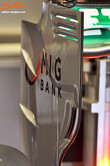 Furthermore as we can see (right) the team has followed many others by adding small fins to the outer section of the endplate. These manage the vortices created by the endplate creating a more efficient area.
Furthermore as we can see (right) the team has followed many others by adding small fins to the outer section of the endplate. These manage the vortices created by the endplate creating a more efficient area.
Ferrari
The Italian team is once again finding that in the middle of the season it isn't getting the level of correlation from its work in CFD and the wind tunnel with the results on track.
However like many of the teams its development plans have been hindered somewhat by the change of tyre construction that Pirelli implemented a few races ago. Up until that point Ferrari had been working on an extension of its exhaust solution by moving the bodywork rearwards.
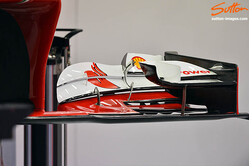 When placed on the car the results were neither mind blowing or perhaps as expected and so all that development now goes back to the drawing board. The return of the 2012 tyre construction has led many teams to stand back and take heed and Ferrari seems to be one of these with the team only really bringing circuit specific developments to the car over the last few races.
When placed on the car the results were neither mind blowing or perhaps as expected and so all that development now goes back to the drawing board. The return of the 2012 tyre construction has led many teams to stand back and take heed and Ferrari seems to be one of these with the team only really bringing circuit specific developments to the car over the last few races.
For Spa the team arrived with a change to its front wing which sees the top flap graduated to reduce downforce and in turn drag.
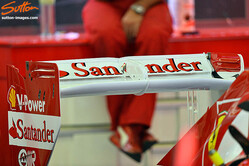 Like Red Bull the team also took the opportunity to 'get its eye in' on a lower downforce rear wing that will likely feature at Monza.
Like Red Bull the team also took the opportunity to 'get its eye in' on a lower downforce rear wing that will likely feature at Monza.
The wing once again features a much lower angle of attack but not as drastic as the one tried by Red Bull. Both teams taking advantage of the similar length straights of Spa to see if these wings work with the off chance they could have substituted their regular wings for these. The poor weather arriving for qualifying put pay to the low downforce wings being used this weekend.
Lotus
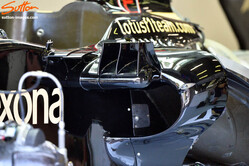 Having announced before this weekend that it was to introduce a longer wheel base chassis, the Enstone team opted not to run it at Spa and instead will introduce the chassis at Monza.
Having announced before this weekend that it was to introduce a longer wheel base chassis, the Enstone team opted not to run it at Spa and instead will introduce the chassis at Monza.
The team did however introduce a new selection of aero components around the top of the sidepods inlet in order to excite the airflow in the region.
Since the start of 2012 the team has run with a singular horizontal cockpit fin that traversed the more forward section of the double section sidepod. Like McLaren its sidepod design features two distinct areas; the forward one which encloses the side impact protection bars and a more rearward section that allows the team to take advantage of a more undercut sidepod. With the re-introduction of the 2012 construction tyres the teams are re-thinking certain areas of the car as the flow construction has changed slightly. With this in mind Lotus arrived with three vortex generators above the sidepod inlet and two fins placed under the wing mirror. Their job is to make the airflow downwashing over the sidepod toward the exhaust operate over a wider speed window.
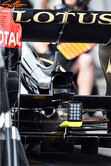 As we have seen many times with Lotus its DRD (Drag Reduction Device) was used during FP1 but with the interruption of rain the team decided to abandon it for the rest of the weekend rather than chase tuning it and losing valuable set up time.
As we have seen many times with Lotus its DRD (Drag Reduction Device) was used during FP1 but with the interruption of rain the team decided to abandon it for the rest of the weekend rather than chase tuning it and losing valuable set up time.
Raikkonen's consecutive race finishing streak finally came to an end at Spa with a brake failure that saw the Finn park the car in the garage after going straight on at the chicane.
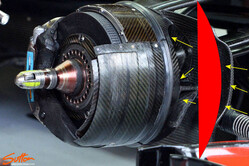 As we can see from the image of Lotus' front brake duct the outer fin that controls the airflow sits exceptionally close to the tyre itself whilst the airflow moves en mass to the more rearward inlets which is then distributed around the hub to cool the brakes. (In the image the red section added by myself depicts where the tyre normally sits so you have an idea of how the opening to the inlet looks and then opens up to feed 3 internal tracts). The team announced after the race that it was in fact a visor tear-off that had become lodged inside the inlet that caused the brake to overheat. It was swiftly removed at Raikkonen's first stop but the damage was already done ,with the brake being over heated it was retained in the hub until it finally failed in the second stint.
As we can see from the image of Lotus' front brake duct the outer fin that controls the airflow sits exceptionally close to the tyre itself whilst the airflow moves en mass to the more rearward inlets which is then distributed around the hub to cool the brakes. (In the image the red section added by myself depicts where the tyre normally sits so you have an idea of how the opening to the inlet looks and then opens up to feed 3 internal tracts). The team announced after the race that it was in fact a visor tear-off that had become lodged inside the inlet that caused the brake to overheat. It was swiftly removed at Raikkonen's first stop but the damage was already done ,with the brake being over heated it was retained in the hub until it finally failed in the second stint.
McLaren
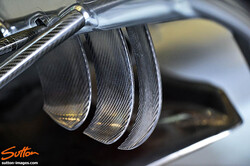 Since the switch to the 2012 construction tyres by Pirelli life at McLaren has eased a little, too far back to mount a title challenge, over the last few races, the team has set about beating Force India.
Since the switch to the 2012 construction tyres by Pirelli life at McLaren has eased a little, too far back to mount a title challenge, over the last few races, the team has set about beating Force India.
With the team firmly concentrating on providing solutions for the MP4-28 that can be re-used or learnt from for next year's car McLaren has also retrofitted the car with several components. I mentioned the team returning to the multi element turning vanes at the last race in Hungary but a decent picture alluded me – but on the right you will find a great image captured by Suttons.
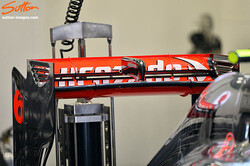 The team also adopted a rear wing very reminiscent of its 2012 specification for Spa with a much shallower angle of attack than it usually uses.
The team also adopted a rear wing very reminiscent of its 2012 specification for Spa with a much shallower angle of attack than it usually uses.
From here on in it's difficult to see how McLaren, which has now overhauled Force India, will finish behind them with Woking outfit in the ascendancy and its Silverstone rivals having already declared they won't continue to develop their 2013 car.
Force India
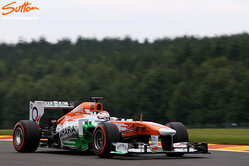 Like all the other teams around it, Force India took a lower configuration downforce rear wing to Spa. As mentioned above however it seems the team is now going to firmly concentrate its efforts on 2014 and will likely slip a little further behind McLaren as the season progresses.
Like all the other teams around it, Force India took a lower configuration downforce rear wing to Spa. As mentioned above however it seems the team is now going to firmly concentrate its efforts on 2014 and will likely slip a little further behind McLaren as the season progresses.
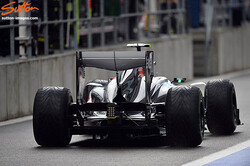 Like Lotus, Sauber has continued to assess DRD (Drag Reduction Device) throughout the tail end of last season and the beginning of this. Its 2013 challenger was specifically designed with DRD in mind but being caught out by the change of tyre construction at the start of the season the team had to make the necessary alterations to recover the loss in consistent downforce. The team ran its DRD during the Friday sessions and it looked likely it would continue to run it had the weather not been a factor.
Like Lotus, Sauber has continued to assess DRD (Drag Reduction Device) throughout the tail end of last season and the beginning of this. Its 2013 challenger was specifically designed with DRD in mind but being caught out by the change of tyre construction at the start of the season the team had to make the necessary alterations to recover the loss in consistent downforce. The team ran its DRD during the Friday sessions and it looked likely it would continue to run it had the weather not been a factor.
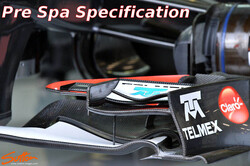 The team also made the largest revision to its front wing we have seen in some time with a new cascade arrangement.
The team also made the largest revision to its front wing we have seen in some time with a new cascade arrangement.
Previously the team has used a main and smaller cascade with a horizontal blade traversing the main cascade. The new iteration features a much shallower AoA and disregards the horizontal blade, whilst the smaller inner cascade has been deleted altogether.
 You'll also note the outer endplate of the cascade bends towards the outside of the wing along with a centralised fin within the cascade doing the same. This is done to further condition the airflow around the outside of the front tyre.
You'll also note the outer endplate of the cascade bends towards the outside of the wing along with a centralised fin within the cascade doing the same. This is done to further condition the airflow around the outside of the front tyre.
Learn more about Matt and check out his previous features, here